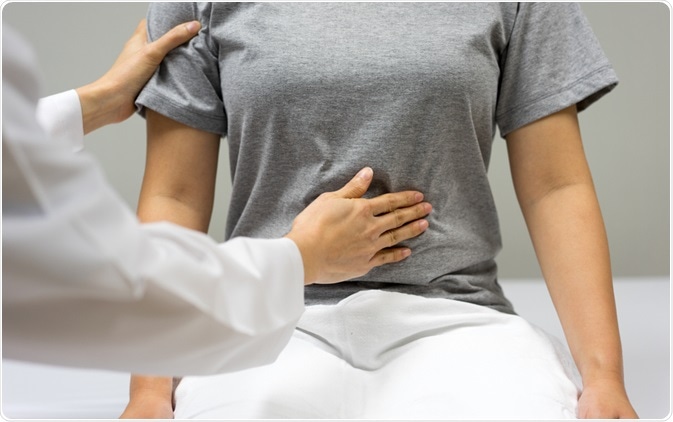Pseudomyxoma peritonei (PMP) is difficult to diagnose. For diagnosing PMP as well as verifying the development of the disease, several tests are available. PMP can often be found during treatment for another disease or an operation performed for other medical problems.
 Image Credit: nuiza11/Shutterstock.com
Image Credit: nuiza11/Shutterstock.com
The selection of tests applicable to a particular patient as well as the frequency of the tests is discussed with a doctor. The tests vary depending on the symptoms that arise. All tests are not applicable to every patient.
CT scan
A computed tomography (CT) scan displays a 3D image of the inner part of the body on the computer screen by taking a number of X-ray measurements. This picture helps to easily view a pouch of mucin, its developing stage, and the path of improvement of the disease.
The scan takes a short time to provide an image; it can be around 10–30 min. A small amount of radiation is used for scanning and it is a pain-free technique.
The doctor advises the patient to fast at least four hours before undergoing the scanning process. For more in-depth investigation, the patients are required to have dye injection that will help to highlight structures of interest.
The doctor must ensure that the patient who requires a dye does not have asthma, or iodine allergy, because it may cause dangerous reactions.
MRI scan
A magnetic resonance imaging (MRI) scan is similar to a CT scan. Instead of X-rays, a strong magnetic field and magnets are used to picture various types of tissues within the body. It provides an image of the cross-sectional area of the stomach, which is used by the doctor to analyze the unusual functioning of a tissue or an abnormality in a specific organ.
Compared with a CT scan, it is very safe, because here radiation is not used. However, it can take a longer time to capture pictures than a CT scan and is more expensive.
Ultrasound scan
An ultrasound scan or sonography creates pictures of inner parts of the abdomen, such as kidneys, spleen, liver, pancreas, and small and large intestine, which are displayed on a computer screen. Unlike other techniques, which use radiation or X-rays, it uses sound waves. Therefore, it is non-dangerous.
An ultrasound gel is applied to the abdomen. Very high-frequency sound waves are introduced into the abdomen through the gel by using a small probe (transducer). Thereafter, the sound waves reflect back from the abdomen, which is collected in the transducer.
Then, they are sent to the computer, which converts the sound waves into pictorial representation, which is examined by the doctor.
Biopsy
A biopsy is one of the important tests because it provides the doctor with clear information about the cell from which the tumor has progressed. Thereafter, various types of biopsy tests are carried out on the cells for further verification.
These tests are done by cutting a small portion of body cells or tissue. A pathologist (specialized in examining body cells) analyzes the removed portion under a microscope. In some cases, the doctor needs the help of an ultrasound or CT scan to direct the biopsy needle to cut the correct portion of tissue.
For some patients, a number of biopsies are needed to get clarification on the tumor. However, it does not require a long-term stay in the hospital.
Various types of biopsy tests involved in the examination of tissue or cells are:
- CT or ultrasound-guided biopsy
- Core needle biopsy
- Fine needle aspiration (FNA) biopsy
- Excision biopsy
- Cone biopsy
- Surgical biopsy
Colonoscopy
A colonoscopy is especially used for examining the inner lining of the colon. Before colonoscopy is performed, the nurse or doctor gives a sedative to the patient, which makes him/her feel relaxed.
Thereafter, the patient is required to lie down comfortably on a bed.
Once the patient is made comfortable, the doctor inserts a thin adjustable tube (a colonoscope) into the anus. The flexible tube is easy to move inside the curves of the bowel. At the end of the tube, a light and camera are attached to view any unusual or abnormal areas.
The inner lining of the bowel is photographed using the light and camera. The doctor then examines that picture.
Blood tests
These tests are used to know the level of “tumor markers” present in the blood. Tumor markers are made from the body cells, which may be at a benign or malignant stage.
Generally, the tumor marker noted for pseudomyxoma peritonei (PMP) is CAE—carcinoembryonic antigen.
Pseudomyxoma Peritonei
References
Further Reading